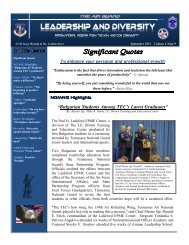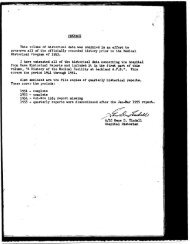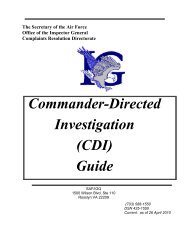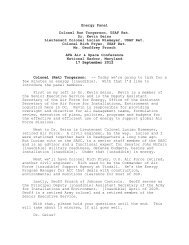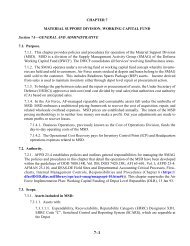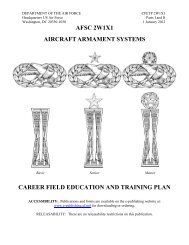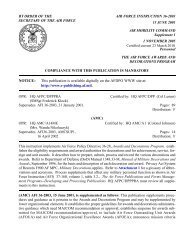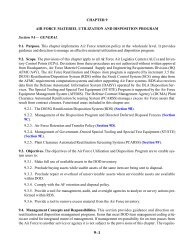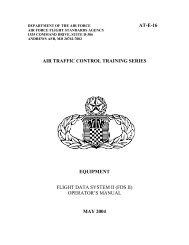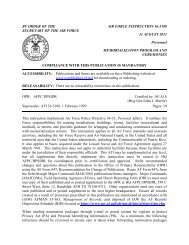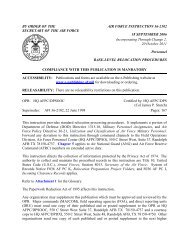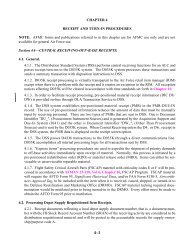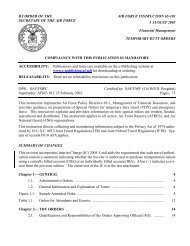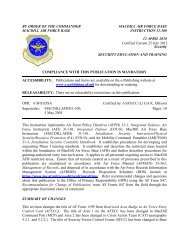Operational History of the 552 - Air Force Link
Operational History of the 552 - Air Force Link
Operational History of the 552 - Air Force Link
Create successful ePaper yourself
Turn your PDF publications into a flip-book with our unique Google optimized e-Paper software.
55<strong>552</strong>2 dd<br />
<strong>552</strong> dd<br />
Ai irrbboorrnnee Eaarrl lyy Waarrnni inngg aanndd Coonnt<br />
Operattiionall Hiissttory <strong>of</strong>f t<strong>the</strong><br />
Aiir Conttroll Wiing 1955--2000<br />
<strong>552</strong> d <strong>Air</strong> Control Wing <strong>History</strong> Office<br />
MSgt Kenneth K. LaFayette and J. Scott Newberry<br />
trrool l<br />
Wi inngg<br />
<strong>Air</strong>borne early warning and control operations commenced with <strong>the</strong> establishment <strong>of</strong> <strong>Air</strong> Defense<br />
Command (ADC) in early 1950. <strong>Air</strong>borne systems provided seaward extensions to land-based early<br />
warning radar and assisted in controlling friendly interceptor aircraft. The <strong>552</strong> d <strong>Air</strong>borne Early Warning<br />
and Control Wing (AEW&CW) adopted <strong>the</strong>se roles when it activated as a provisional wing, on 8 July<br />
1955 at McClellan AFB, California. Initially, ADC assigned <strong>the</strong> <strong>552</strong> AEW&CW to <strong>the</strong> 8 th <strong>Air</strong> Division<br />
(AD). At that time, <strong>552</strong> AEW&CW flying squadrons included <strong>the</strong> 963 d and 964 th <strong>Air</strong>borne Early<br />
Warning and Control Squadrons (AEW&CS). Exactly one month later, on 8 August 1955, <strong>the</strong> 965<br />
AEW&CS joined <strong>the</strong> wing. Training occupied <strong>the</strong> <strong>552</strong> d <strong>Air</strong>borne Early Warning and Control Wing’s first<br />
months until mid-March 1956, when <strong>the</strong> <strong>552</strong> AEW&CW became an operational part <strong>of</strong> <strong>the</strong> ADC’s radar<br />
network.<br />
Figure 5 - An EC-121 on <strong>the</strong> flight line in Sou<strong>the</strong>ast Asia.<br />
<strong>Operational</strong> command and control over <strong>the</strong> <strong>552</strong> AEW&CW transferred to <strong>the</strong> Western <strong>Air</strong><br />
Defense <strong>Force</strong> in July 1957 and changed again in July 1960 to <strong>the</strong> 28 th <strong>Air</strong> Division. In <strong>the</strong> interim (late<br />
1958), <strong>the</strong> mission had expanded to include “gap-filler” duty when ground-based radar stations became<br />
temporarily inoperative. By <strong>the</strong>n, <strong>the</strong> <strong>552</strong> AEW&CW also supported US space activities. The <strong>552</strong> d<br />
<strong>Air</strong>borne Early Warning and Control Wing aircraft, aircrews, and support personnel regularly deployed to<br />
remote areas <strong>of</strong> <strong>the</strong> Pacific region to track ballistic missiles and aid recovery aircraft by pinpointing<br />
missile impacts. Later, <strong>the</strong> <strong>552</strong> AEW&CW provided similar support for <strong>the</strong> Discovery and Mercury<br />
series space missions. In addition, <strong>the</strong> <strong>552</strong> AEW&CW aircraft vectored US Navy units to <strong>the</strong> first<br />
recovery <strong>of</strong> an orbiting earth satellite (Discoverer XIII) on 11 August 1960. Later, <strong>552</strong> AEW&CW TC-<br />
121D aircraft vectored and controlled <strong>Air</strong> <strong>Force</strong> C-119s, which recovered Discoverer XIV’s capsule in <strong>the</strong><br />
air.<br />
1
The <strong>552</strong> d <strong>Air</strong>borne Early Warning and Control Wing soon grew to four flying squadrons with <strong>the</strong><br />
1 May 1963 assignment <strong>of</strong> <strong>the</strong> 966 AEW&CS. Beginning in April 1965, <strong>the</strong> <strong>552</strong> AEW&CW kept part <strong>of</strong><br />
its resources deployed in Sou<strong>the</strong>ast Asia as part <strong>of</strong> <strong>the</strong> “Big Eye Task <strong>Force</strong>” (later dubbed “College Eye<br />
Task <strong>Force</strong>”). Nearly every member <strong>of</strong> <strong>the</strong> <strong>552</strong> AEW&CW served one or more tours <strong>of</strong> duty, on a<br />
rotational basis, with that force. The task force vectored and controlled friendly aircraft and provided<br />
airborne early warning services to allied aircraft throughout <strong>the</strong> war. By late 1968, <strong>the</strong> task force had<br />
become a <strong>552</strong> AEW&CW formal detachment.<br />
The College Eye Task<br />
<strong>Force</strong> continued operations and<br />
flew missions from at least eight<br />
different locations during <strong>the</strong> war.<br />
Flying EC-121Ds and EC-121Ts<br />
(<strong>the</strong> Ds were manually controlled<br />
and <strong>the</strong> T-models partly<br />
“computerized,” a transition step<br />
between <strong>the</strong> 121 and <strong>the</strong> E-3), <strong>the</strong><br />
task force flew combat operations<br />
until August <strong>of</strong> 1973 when <strong>552</strong><br />
AEW&CW flew its last active<br />
combat mission. It stayed in<br />
Sou<strong>the</strong>ast Asia 10 more months<br />
before inactivating on 30 June<br />
1974.<br />
It took nearly 300<br />
Figure 6 - An interior shot <strong>of</strong> <strong>the</strong> aircrew at work inside an EC-121. temporary duty (TDY) aircrew<br />
and maintenance personnel to<br />
keep College Eye going. All <strong>552</strong> AEW&CW personnel performed 60-90 day TDYs from <strong>the</strong>ir home<br />
station <strong>of</strong> McClellan AFB, California, with each member averaging one TDY per year. Only three staff<br />
positions (two at Tainan AB, Taiwan and one at Kwang Ju AB, Republic <strong>of</strong> Korea) were not supported by<br />
TDYs. The <strong>552</strong> AEW&CW personnel on TDY rotations performed all o<strong>the</strong>r operational, maintenance<br />
and staff positions for College Eye.<br />
By <strong>the</strong> end <strong>of</strong> American involvement in Vietnam, College Eye had produced a proud record <strong>of</strong><br />
accomplishments. College Eye had controlled over 210,000 aircraft; issued 700 MIG warnings; flown<br />
4,713 combat missions for 48,954.3 combat hours; and perhaps most importantly, assisted in <strong>the</strong> recovery<br />
<strong>of</strong> 80 downed US aircrew members.<br />
In April 1967, Fourth <strong>Air</strong> <strong>Force</strong> assumed command and control over <strong>the</strong> <strong>552</strong> d <strong>Air</strong>borne Early<br />
Warning and Control Wing. In November <strong>of</strong> 1969, <strong>the</strong> <strong>552</strong> AEW&CW again realigned, this time under<br />
Aerospace Defense Command. On New Year’s Eve 1969, <strong>the</strong> <strong>Air</strong> <strong>Force</strong> inactivated <strong>the</strong> 551 AEW&CW,<br />
<strong>the</strong> <strong>552</strong> AEW&CW’s sister wing. The <strong>552</strong> AEW&CW transitioned to flying warning and control routes<br />
along <strong>the</strong> eastern seaboard <strong>of</strong> <strong>the</strong> United States and Iceland.<br />
2
55<strong>552</strong>2 dd<br />
Figure 7 - An aerial picture <strong>of</strong> <strong>the</strong> College Eye facilities at Korat Royal Thai <strong>Air</strong> <strong>Force</strong> Base.<br />
Ai irrbboorrnnee Waarrnni inngg aanndd Coonnt trrool l<br />
Grroouupp<br />
On 1 July 1974, <strong>the</strong> <strong>Air</strong> <strong>Force</strong> redesignated <strong>the</strong> <strong>552</strong> d <strong>Air</strong>borne Early Warning and Control Wing as<br />
<strong>the</strong> <strong>552</strong> d <strong>Air</strong>borne Warning and Control Group. Then, in line with <strong>the</strong> <strong>Air</strong> <strong>Force</strong>’s plan to relocate <strong>the</strong><br />
airborne warning and control mission to ano<strong>the</strong>r, more centrally located base, reductions soon hit <strong>the</strong> unit.<br />
By mid-1975, <strong>the</strong>se cutbacks had limited <strong>the</strong> <strong>552</strong> d <strong>Air</strong>borne Warning and Control Group to one flying<br />
squadron, a training squadron, a maintenance squadron, and a single detachment. From <strong>the</strong>n until 30<br />
April 1976, <strong>the</strong> unit operated on a vastly reduced scale. The <strong>552</strong> d <strong>Air</strong>borne Warning and Control Group<br />
and <strong>the</strong> 963 <strong>Air</strong>borne Warning and Control Squadron ended <strong>the</strong>ir transformation with <strong>the</strong>ir inactivation 30<br />
April 1976.<br />
55<strong>552</strong>2 dd<br />
Ai irrbboorrnnee Waarrnni inngg aanndd Coonnt<br />
trrool l<br />
Wi inngg<br />
On 5 May 1976, <strong>the</strong> inactivation lasted less than a week however, as <strong>the</strong> <strong>Air</strong> <strong>Force</strong> again activated<br />
<strong>the</strong> unit and redesignated it as <strong>the</strong> <strong>552</strong> d <strong>Air</strong>borne Warning and Control Wing (AWACW). On 1 July<br />
1976, <strong>the</strong> <strong>552</strong> AWACW relocated to Tinker AFB, Oklahoma. The <strong>552</strong> AWACW reported directly to<br />
Headquarters, Tactical <strong>Air</strong> Command (TAC). In addition, on 1 July 1976, TAC activated three squadrons<br />
(<strong>the</strong> 963 d <strong>Air</strong>borne Warning and Control Squadron [AWACS], 966 th <strong>Air</strong>borne Warning and Control<br />
Training Squadron, and <strong>the</strong> <strong>552</strong> d Consolidated <strong>Air</strong>craft Maintenance Squadron) and assigned <strong>the</strong>m under<br />
<strong>the</strong> <strong>552</strong> AWACW. On 1 October 1976, <strong>the</strong> 7 th <strong>Air</strong>borne Command and Control Squadron (7 ACCS),<br />
stationed at Keesler AFB, Mississippi, began reporting to <strong>the</strong> <strong>552</strong> AWACW.<br />
Taking on a worldwide commitment, <strong>the</strong> <strong>552</strong> d <strong>Air</strong>borne Warning and Control Wing initiated E-3<br />
<strong>Air</strong>borne Warning and Control Systems (AWACS) operations in early 1977. On 1 July 1977, <strong>the</strong> <strong>552</strong><br />
AWACW fur<strong>the</strong>r expanded when TAC redesignated and activated <strong>the</strong> 964 AWACS. On 1 January 1978,<br />
six months later, <strong>the</strong> 8 th Tactical Deployment Control Squadron (TDCS) joined <strong>the</strong> <strong>552</strong> AWACW, and on<br />
1 July 1978, <strong>the</strong> 965 AWACS reappeared as part <strong>of</strong> <strong>the</strong> <strong>552</strong> d <strong>Air</strong>borne Warning and Control Wing. In <strong>the</strong><br />
Fall <strong>of</strong> 1978, internal organizational realignment highlighted activities with <strong>the</strong> inactivation <strong>of</strong> <strong>the</strong> <strong>552</strong><br />
CAMS and <strong>the</strong> activation <strong>of</strong> <strong>the</strong> <strong>552</strong> d Component Repair Squadron (CRS) and <strong>the</strong> <strong>552</strong> d <strong>Air</strong>craft<br />
Generation Squadron (AGS).<br />
3
In early 1979, <strong>the</strong> <strong>552</strong> d <strong>Air</strong>borne<br />
Warning and Control Wing assumed a<br />
readiness role in support <strong>of</strong> North<br />
American Aerospace Defense<br />
Command (NORAD). The <strong>552</strong><br />
AWACW aircraft and aircrews stood on<br />
alert, ready to fly short-notice missions<br />
to sectors along <strong>the</strong> US-Canadian<br />
border for airborne radar coverage in<br />
defense <strong>of</strong> <strong>the</strong> North American<br />
continent. On 1 September 1979,<br />
organizationally, <strong>the</strong> <strong>552</strong> AWACW<br />
expanded incorporating <strong>the</strong> 960 th<br />
<strong>Air</strong>borne Warning and Control Support<br />
Squadron, and on 1 October 1979 <strong>the</strong><br />
961 st <strong>Air</strong>borne Warning and Control<br />
Support Squadron. Later in 1982, <strong>the</strong><br />
USAF redesignated both squadrons<br />
removing “Support” from <strong>the</strong>ir designations.<br />
Figure 8 - A rare photo <strong>of</strong> <strong>the</strong> EC-121<br />
and E-3 sharing ramp space at Tinker AFB, Oklahoma.<br />
In October 1979, two E-3 aircraft, 240 aircrew, and support personnel responded to a short-notice<br />
deployment to South Korea following <strong>the</strong> assassination <strong>of</strong> President Park Chung Hee. The mobility<br />
section had <strong>the</strong> entire deployment package airborne in less than six hours. Over <strong>the</strong> course <strong>of</strong> <strong>the</strong> next two<br />
months, E-3 aircraft and aircrews flew 54 missions, totaled 370 flying hours and provided “deep look”<br />
surveillance into <strong>the</strong> Korean peninsula. In addition, during <strong>the</strong> deployment <strong>the</strong> E-3 detachment provided<br />
extensive joint training for <strong>the</strong> US and Republic <strong>of</strong> Korea air defense forces.<br />
From December 1979 through May 1980, ano<strong>the</strong>r deployment package <strong>of</strong> two E-3 aircraft, two<br />
aircrews, and support personnel accomplished joint training operations in Central Europe and <strong>the</strong><br />
Mediterranean region supporting <strong>the</strong> US Navy Sixth Fleet and Allied forces. The training deployment<br />
also featured <strong>the</strong> first E-3 AWACS visit to Egypt.<br />
On 1 July 1980, <strong>the</strong> <strong>552</strong> AWACW expanded with <strong>the</strong> realignment <strong>of</strong> <strong>the</strong> 41 st Electronic Control<br />
Squadron (ECS). On 1 October 1980, four E-3s and approximately 200 personnel deployed to Saudi<br />
Arabia in support <strong>of</strong> European Liaison <strong>Force</strong> One (ELF One) operations. The Iran-Iraq War caused<br />
concerns in both <strong>the</strong> United States and Saudi Arabia. They believed that <strong>the</strong> conflict could “spill-over”<br />
into <strong>the</strong> adjacent Gulf region countries. Planners organized ELF-One to counter this threat and<br />
demonstrated American resolve, and <strong>the</strong> United States sent a symbol <strong>of</strong> <strong>the</strong>ir commitment in <strong>the</strong> E-3A<br />
Sentry.<br />
4
The <strong>552</strong> AWACW supported ELF-One, and continued to provide “around-<strong>the</strong>-clock” airborne radar<br />
coverage during <strong>the</strong> entire course <strong>of</strong> <strong>the</strong> eight-year war. In fact, <strong>the</strong> E-3’s ELF-One obligation did not<br />
<strong>of</strong>ficially end until 16 April<br />
1989.<br />
In December 1980,<br />
four E-3 aircraft, aircrews,<br />
and support personnel<br />
deployed to Ramstein <strong>Air</strong><br />
Base (AB), West Germany,<br />
to conduct joint training<br />
with elements <strong>of</strong> <strong>the</strong> NATO<br />
air defense network. This<br />
deployment coincided with<br />
increased international<br />
tension over a possible<br />
Warsaw Pact invasion <strong>of</strong><br />
Poland. Two <strong>552</strong> AWACW<br />
E-3 aircraft, aircrews, and support personnel already on temporary assignment at Keflavik Naval <strong>Air</strong><br />
Station (NAS), Iceland, while two o<strong>the</strong>r E-3 packages traveled from Tinker AFB. By mid-January 1981,<br />
<strong>the</strong> crisis in Poland subsided allowing <strong>the</strong> E-3 aircraft and aircrews to redeploy back to Iceland and<br />
eventually home to Tinker. However, short duration E-3 training flights to <strong>the</strong> European continent<br />
continued <strong>the</strong>reafter. Later, in October 1981, two <strong>552</strong> d Figure 9 - An EC-130H Compass Call <strong>of</strong> <strong>the</strong> 41<br />
<strong>Air</strong>borne Warning and Control Wing E-3 aircraft<br />
revisited Egypt following <strong>the</strong> assassination <strong>of</strong> President Anwar el-Sadat.<br />
st Electronic Combat Squadron.<br />
In August 1983, <strong>the</strong> <strong>552</strong> AWACW sent a single support package to Sudan to provide airborne<br />
radar coverage in that nation as it repelled rebel forces near Khartoum. That same year, <strong>552</strong> AWACW<br />
activities increased in <strong>the</strong> Pacific <strong>the</strong>ater following <strong>the</strong> Soviet military air forces downing <strong>of</strong> a Korean<br />
<strong>Air</strong>lines, Flight 007. From 1 to 15 September 1983, <strong>the</strong> <strong>552</strong> d supported <strong>the</strong> salvage operation and earned<br />
an <strong>Air</strong> <strong>Force</strong> Outstanding Unit Award (AFOUA) in <strong>the</strong> process.<br />
55<strong>552</strong>2 dd<br />
Ai irrbboorrnnee Waarrnni inngg aanndd Coonnt<br />
trrool l<br />
Di ivvi issi ioonn<br />
On 1 October 1983, <strong>the</strong> <strong>552</strong> AWACW’s missions and composition expanded so dramatically that<br />
<strong>the</strong> <strong>Air</strong> <strong>Force</strong> elevated <strong>the</strong> unit to division status and redesignating it as <strong>the</strong> <strong>552</strong> d <strong>Air</strong>borne Warning and<br />
Control Division. On 1 November 1983, <strong>the</strong> <strong>552</strong> d <strong>Air</strong>borne Warning and Control Division continued to<br />
grow as it took on <strong>the</strong> 4<strong>552</strong> d Tactical Training Squadron (TTS) (inactivated two months later and<br />
redesignated as <strong>the</strong> <strong>552</strong> TTS on 1 January 1984).<br />
5
55<strong>552</strong>2 dd<br />
Ai irrbboorrnnee Waarrnni inngg aanndd Coonnt<br />
On 1 April 1985, TAC<br />
again redesignated <strong>the</strong> <strong>552</strong> d<br />
<strong>Air</strong>borne Warning and Control<br />
Division and returned it to Wing<br />
status. At <strong>the</strong> same time, TAC<br />
activated <strong>the</strong> 28 th <strong>Air</strong> Division at<br />
Tinker AFB to assume<br />
intermediate administrative and<br />
command and control functions<br />
over <strong>the</strong> <strong>552</strong> AWACW. In<br />
conjunction, Headquarters TAC<br />
immediately transferred <strong>the</strong> 7<br />
ACCS, 41 ECS, 960, and 961<br />
AWACS to <strong>the</strong> 28 AD. On 1<br />
trrool l<br />
Wi inngg (Ennccoorree) ( )<br />
Figure 10 - An 8 TDCS aircraft, 55-3118 (The City <strong>of</strong> Renton)<br />
rests on <strong>the</strong> ground at Tinker AFB, Oklahoma.<br />
March 1986, <strong>the</strong> 8 TDCS followed suit and transferred under <strong>the</strong> 28 th AD. From August through<br />
November 1986, <strong>the</strong> 3d <strong>Air</strong>borne Command and Control Squadron also provided short-lived growth to<br />
<strong>the</strong> <strong>552</strong> AWACW’s unit strength.<br />
Thhee Enndd<br />
o<strong>of</strong> f ELFF- -Onnee/ /JJUSST CAUSSE<br />
On 16 April 1989, <strong>the</strong> <strong>552</strong> AWACW ended its eight-year deployment to Saudi Arabia, having<br />
flown more than 6,000 sorties and 87,000 hours in support <strong>of</strong> ELF-One. In August 1989, <strong>the</strong> <strong>552</strong><br />
AWACW again expanded its mission, becoming involved in <strong>the</strong> war against drugs. Under higher<br />
headquarters’ direction, <strong>the</strong> wing began patrolling <strong>the</strong> sou<strong>the</strong>rn border <strong>of</strong> <strong>the</strong> United States and beyond.<br />
On 20 December 1989, Operation JUST CAUSE highlighted <strong>the</strong> early anti-drug campaign and featured<br />
<strong>552</strong> d <strong>Air</strong>borne Warning and Control Wing participation in <strong>the</strong> invasion <strong>of</strong> Panama and capture <strong>of</strong> Manuel<br />
Antonio Noriega. In February 1990, following JUST CAUSE, <strong>the</strong> <strong>552</strong> AWACW E-3s began flying<br />
routine counter narcotics operations out <strong>of</strong> Roosevelt Roads NAS, Puerto Rico.<br />
DESSERT<br />
SSHIIELD/ /DESSERT SSTORM<br />
On 10 August 1990, <strong>the</strong> <strong>552</strong> d <strong>Air</strong>borne Warning and Control Wing began its deployment to <strong>the</strong><br />
Persian Gulf in support <strong>of</strong> Operation DESERT SHIELD. On 16 January 1991, E-3 support packages <strong>of</strong><br />
<strong>the</strong> <strong>552</strong> AWACW executed airborne control over several <strong>of</strong> <strong>the</strong> initial strikes on Iraq in Operation<br />
DESERT STORM. Beginning on 17 January 1991, aircrews <strong>of</strong> <strong>the</strong> <strong>552</strong> d <strong>Air</strong>borne Warning and Control<br />
Wing flew as part <strong>of</strong> operation PROVEN FORCE in <strong>the</strong> Persian Gulf War. The E-3 aircraft and aircrews<br />
flew a total <strong>of</strong> 7, 314.7 combat hours during DESERT STORM, sustaining a 91.36 percent mission<br />
capable rate. They controlled 31,924 strike sorties and losing a single Allied aircraft in air-to-air action.<br />
In addition, E-3s controlled 20,401 air refueling sorties with tankers <strong>of</strong>f-loading more than 178 million<br />
gallons <strong>of</strong> fuel to 60,543 receivers.<br />
6
55<strong>552</strong>2 dd<br />
Ai irr Coonnt<br />
trrool l<br />
Wi inngg<br />
In October 1991, Tactical <strong>Air</strong> Command once more redesignated <strong>the</strong> <strong>552</strong> d <strong>Air</strong>borne Warning and Control<br />
Wing, this time naming it <strong>the</strong> <strong>552</strong> d <strong>Air</strong> Control Wing (ACW). On 1 November 1991, TAC redesignated<br />
<strong>the</strong> <strong>552</strong> Tactical Training Squadron (TTS) as <strong>the</strong> <strong>552</strong> d<br />
Training Squadron. Then, on 28 May 1992, TAC<br />
assigned <strong>the</strong> 3d Combat Communications Group (CCG)<br />
to <strong>the</strong> <strong>552</strong> ACW. On <strong>the</strong> following day, 29 May 1992,<br />
TAC inactivated <strong>the</strong> 28 AD and <strong>the</strong> <strong>552</strong> ACW realigned<br />
directly under TAC. In addition on 29 May 1992, <strong>the</strong><br />
internal composition <strong>of</strong> <strong>the</strong> <strong>552</strong> d <strong>Air</strong> Control Wing<br />
changed with <strong>the</strong> inactivation <strong>of</strong> <strong>the</strong> <strong>552</strong> EMS and <strong>the</strong><br />
<strong>552</strong> CRS. In turn, TAC activated <strong>the</strong> <strong>552</strong> d Operations<br />
Group (OG), <strong>552</strong> d Logistics Group (LG), and <strong>552</strong> d<br />
Computer Systems Group (CSG). The <strong>552</strong> d <strong>Air</strong>craft<br />
Generation Squadron (later redesignated <strong>552</strong> d<br />
Maintenance Squadron) remained intact under <strong>the</strong> <strong>552</strong><br />
LG. (The <strong>552</strong> MS absorbed <strong>the</strong> remnants <strong>of</strong> <strong>the</strong> EMS<br />
and CRS.) The 963 d , 964 th , 965 th , <strong>Air</strong>borne Warning and<br />
Control Squadrons and 966 th <strong>Air</strong>borne Warning and<br />
Control Training Squadron remained active under <strong>the</strong><br />
<strong>552</strong> OG. On 1 June 1992, <strong>the</strong> <strong>552</strong> ACW Wing migrated<br />
from assignment under TAC to <strong>the</strong> newly activated <strong>Air</strong><br />
Combat Command (ACC). On 1 October 1992, HQ<br />
Figure 11 - A member <strong>of</strong> <strong>the</strong> 964<br />
ACC’s final act <strong>of</strong> reorganization placed <strong>the</strong> <strong>552</strong> ACW<br />
under <strong>the</strong> intermediate command <strong>of</strong> Second <strong>Air</strong> <strong>Force</strong>.<br />
th mans his terminal.<br />
In 1993, <strong>the</strong> <strong>552</strong> ACW continued its worldwide force projection mission. The <strong>552</strong> ACW<br />
maintained E-3 support packages in Southwest Asia in support <strong>of</strong> Operations PROVIDE COMFORT and<br />
SOUTHERN WATCH, and deployed E-3s for <strong>the</strong> air-interdiction war on drugs coming out <strong>of</strong> South<br />
America. On 1 July 1993, <strong>the</strong> <strong>552</strong> ACW ended its short tenure with Second <strong>Air</strong> <strong>Force</strong> and came under <strong>the</strong><br />
auspices <strong>of</strong> Twelfth <strong>Air</strong> <strong>Force</strong>. On 17 July 1993, <strong>the</strong> 7 ACCS EC-130E <strong>Air</strong>borne Battlefield Command<br />
and Control Center (ABCCC) aircraft and aircrews served in Operation DENY FLIGHT at Aviano AB,<br />
Italy. United Nations operation DENY FLIGHT sought to facilitate <strong>the</strong> end <strong>of</strong> <strong>the</strong> civil war between <strong>the</strong><br />
Croatians and <strong>the</strong> Serbians in <strong>the</strong> former Yugoslavia. On 8 October 1993, a final wing reorganization<br />
move occurred when ACC activated <strong>the</strong> 34 th Combat Communications Squadron.<br />
The fall <strong>of</strong> <strong>the</strong> Soviet empire led to improved relations between Eastern Europe and <strong>the</strong> United<br />
States. On 15 March 1994, in light <strong>of</strong> <strong>the</strong> advances in this area, <strong>the</strong> <strong>552</strong> d <strong>Air</strong> Control Wing hosted two<br />
key members <strong>of</strong> <strong>the</strong> Polish military. The <strong>552</strong> ACW provided <strong>the</strong> Polish visitors a tour <strong>of</strong> <strong>the</strong> E-3 aircraft<br />
and detailed briefings on <strong>the</strong> E-3 AWACS aircraft capabilities.<br />
In March 1994, ano<strong>the</strong>r history-making event occurred in <strong>the</strong> <strong>552</strong> ACW when <strong>the</strong> 175 th Fighter<br />
Wing, Maryland <strong>Air</strong> National Guard chose First Lieutenant Julie E. Petrina as <strong>the</strong> first female A-10 pilot.<br />
She performed as <strong>the</strong> executive <strong>of</strong>ficer for <strong>the</strong> <strong>552</strong> d Computer Systems Group.<br />
In April <strong>of</strong> 1994, many events occurred that would impact <strong>the</strong> organization <strong>of</strong> <strong>the</strong> <strong>552</strong> d <strong>Air</strong> Control<br />
Wing and <strong>the</strong> business <strong>of</strong> airborne command and control. On 1 April 1994, in accordance with <strong>the</strong><br />
7
USAF’s reorganization and restructuring system, <strong>the</strong> 3 CCG became a direct reporting unit under Twelfth<br />
<strong>Air</strong> <strong>Force</strong>. Their short tenure with <strong>the</strong> <strong>552</strong> ACW lasted barely 23 months.<br />
Bl laacckkhhaawkk<br />
Heel li iccooppt teerr SShhoooot tddoownn<br />
On 14 April 1994, ano<strong>the</strong>r significant event occurred. Two USAF F-15s controlled by a <strong>552</strong><br />
ACW E-3 aircraft and aircrew accidentally shot down two US Army “Blackhawk” helicopters while <strong>the</strong>y<br />
passed through <strong>the</strong> nor<strong>the</strong>rn Iraq “no-fly zone.” The F-15s had mistaken <strong>the</strong> two aircraft for Soviet built<br />
“HIND” helicopters. This “friendly fire” incident led to <strong>the</strong> deaths <strong>of</strong> 26 people and galvanized national<br />
interest in E-3 activities. This unfortunate accident also provided <strong>the</strong> genesis for a massive recertification<br />
process for all 1,300 airborne warning and control aircrew members.<br />
On 1 July 1994, Headquarters ACC directed <strong>the</strong> 963 d , 964 th , 965 th <strong>Air</strong>borne Warning and Control<br />
Squadrons and 966 th <strong>Air</strong>borne Warning and Control Training Squadron all be redesignated as <strong>Air</strong>borne<br />
<strong>Air</strong> Control Squadrons (AACS). On <strong>the</strong> same day ACC also redesignated <strong>the</strong> 8 ADCS as <strong>the</strong> 8 th <strong>Air</strong>borne<br />
Command and Control Squadron (ACCS).<br />
UPPHOLD/ /MAIINTAIIN DEMOCRACY –– VIIGIILANT WARRIIOR<br />
The autumn <strong>of</strong> 1994, proved a turbulent time for <strong>the</strong> <strong>552</strong> d <strong>Air</strong> Control Wing. During September<br />
and October, <strong>the</strong> <strong>552</strong> ACW found itself involved in two real world contingencies, Operations<br />
UPHOLD/MAINTAIN DEMOCRACY and VIGILANT WARRIOR. The United States, along with<br />
several Caribbean nations, banded toge<strong>the</strong>r to conduct UPHOLD DEMOCRACY. UPHOLD<br />
DEMOCRACY resulted in <strong>the</strong> invasion <strong>of</strong> <strong>the</strong> island nation <strong>of</strong> Haiti to restore its duly elected elected<br />
president Jean-Bertrand Aristide into power. VIGILANT WARRIOR occurred when Iraq once again<br />
tried to flex its military muscles and threatened Kuwait. Luckily, both events ended quickly and quietly.<br />
In UPHOLD DEMOCRACY former President Jimmy Carter led a delegation to peacefully defuse <strong>the</strong><br />
Haitian situation and broker a peaceful US military landing. VIGILANT WARRIOR displayed to <strong>the</strong><br />
Iraqi leaders that <strong>the</strong> US and <strong>the</strong> coalition still planned to defend <strong>the</strong>ir interests in Southwest Asia. After<br />
this delay Iraq thought better <strong>of</strong> <strong>the</strong>ir military aggression and pulled Iraqi troops back from <strong>the</strong> Emirate.<br />
Thus, Iraq avoided ano<strong>the</strong>r armed conflict with <strong>the</strong> US <strong>the</strong> Gulf State and coalition allies.<br />
The <strong>552</strong> d provided missions for SOUTHERN WATCH flying out <strong>of</strong> Riyadh, Saudi Arabia, and<br />
<strong>the</strong>n patrolling <strong>the</strong> skies over sou<strong>the</strong>rn Iraq, monitoring aircraft movements within that country. On 18<br />
September 1994, <strong>552</strong> ACW members flew <strong>the</strong>ir 2,000 th sortie in support <strong>of</strong> Operation SOUTHERN<br />
WATCH aboard tail number 79-0001.<br />
Okkl laahhoomaa<br />
Ci it tyy Boombbi inngg<br />
The <strong>552</strong> d <strong>Air</strong> Control Wing had an exciting year peppered with tribulation in 1995. A shocking<br />
act <strong>of</strong> treachery struck <strong>the</strong> local Oklahoma City community and cast a shadow over <strong>the</strong> <strong>552</strong> d as well.<br />
Terrorists concealed a bomb in a rental truck just outside <strong>the</strong> Alfred P. Murrah Federal Office Building, in<br />
downtown Oklahoma City. At 0902 on Wednesday, 19 April 1995, <strong>the</strong> bomb exploded, killing 168<br />
people and wounding hundreds <strong>of</strong> o<strong>the</strong>rs. Witnesses stated that <strong>the</strong>y felt <strong>the</strong> impact tremors from <strong>the</strong><br />
bomb up to 30 miles away; <strong>the</strong> emotional tremors continue even today. National media compared <strong>the</strong><br />
scenes at <strong>the</strong> Murrah Building to those viewed in devastated Beirut and <strong>the</strong> post apocalyptic scenes that<br />
followed <strong>the</strong> first bombing <strong>of</strong> <strong>the</strong> World Trade Center in New York. The bomb blast shook not only <strong>the</strong><br />
inhabitants <strong>of</strong> Oklahoma City, but also <strong>the</strong> entire United States.<br />
8
Ai irrccrreew<br />
Reecceerrt ti if fi iccaat ti ioonn<br />
An emphasis on training carried over from <strong>the</strong> 1994 <strong>Air</strong>crew Recertification directly related to <strong>the</strong><br />
“Blackhawk” shoot down. Reorganization and expansion again affected <strong>the</strong> <strong>552</strong> ACW when<br />
Headquarters ACC activated <strong>the</strong> 952 d <strong>Air</strong>craft Generation Squadron (Test) and inactivated <strong>the</strong> <strong>552</strong> d<br />
Maintenance Squadron. This ended a four-year experiment on <strong>the</strong> effectiveness <strong>of</strong> a combined<br />
maintenance organization. Headquarters <strong>Air</strong> <strong>Force</strong> approved <strong>the</strong> creation <strong>of</strong> <strong>the</strong> 970 th <strong>Air</strong>borne <strong>Air</strong><br />
Control Squadron, an <strong>Air</strong> <strong>Force</strong> Reserve AWACS unit. Simultaneously, <strong>Air</strong> <strong>Force</strong> authorized an increase<br />
from 28 to 40 AWACS aircrews. Both <strong>of</strong> <strong>the</strong>se actions sought to decrease <strong>the</strong> amount <strong>of</strong> time each<br />
crewmember spent on temporary duty each year, and to increase his/her overall quality <strong>of</strong> life. In<br />
addition, <strong>the</strong> <strong>552</strong> ACW continued support <strong>of</strong> Operations PROVIDE COMFORT, SOUTHERN WATCH,<br />
and DENY FLIGHT.<br />
The <strong>552</strong> d <strong>Air</strong> Control Wing’s <strong>Operational</strong> Readiness Inspection (ORI), Phases I and II, received<br />
very positive results. The <strong>552</strong> ACW Inspections and Exercises branch’s (CVI) preparation for <strong>the</strong> ORI<br />
consisted <strong>of</strong> two Sentry Leap exercises and three Sentry Learn exercises. The <strong>552</strong> ACW CVI section<br />
adopted <strong>the</strong> benchmarking process to help <strong>the</strong> <strong>552</strong>ACW prepare for <strong>the</strong> inspection. Benchmarking<br />
involved <strong>the</strong> wing inspectors observing ACC Inspector General Team ORIs at <strong>the</strong>ir bases. In turn, o<strong>the</strong>r<br />
wings would <strong>the</strong>n observe our inspection to learn how to prepare. This method obviously worked ra<strong>the</strong>r<br />
well as <strong>the</strong> <strong>552</strong> ACW earned Excellent ratings in both <strong>the</strong> Phase I inspection in March 1995, and Phase II<br />
inspection in July 1995.<br />
Thhee<br />
Yuukkl laa 2277 Trraaggeeddyy<br />
On 22 September 1995, tragedy once again struck <strong>the</strong> AWACS community. An E-3 AWACS<br />
aircraft, tail number 77-0354, call sign Yukla 27 crashed at Elmendorf AFB, Alaska, minutes after<br />
take<strong>of</strong>f. The crash resulted in <strong>the</strong> deaths <strong>of</strong> twenty-two <strong>Air</strong> <strong>Force</strong> and two Canadian <strong>Air</strong> <strong>Force</strong> aircrew<br />
members stunning <strong>the</strong> members <strong>of</strong> <strong>the</strong> AWACS community. A flock <strong>of</strong> Canadian geese caused foreign<br />
object damage to <strong>the</strong> E-3 bringing about <strong>the</strong> crash. The catastrophic event marked <strong>the</strong> first loss <strong>of</strong> an US<br />
<strong>Air</strong> <strong>Force</strong> AWACS aircraft to accident or enemy action. The term “Yukla” has its origins in Alaskan<br />
dialect meaning “Eagle.” All 962 d <strong>Air</strong>borne <strong>Air</strong> Control Squadron flights carry this call sign.<br />
Bl loocckk 3300- -3355 Uppggrraaddee<br />
On 4 October 1995, <strong>the</strong><br />
first E-3 AWACS aircraft (tailnumber<br />
80-0137) equipped with<br />
<strong>the</strong> Block 30/35 upgrades arrived<br />
at <strong>the</strong> <strong>552</strong> d <strong>Air</strong> Control Wing. At a<br />
cost <strong>of</strong> approximately $984 million<br />
for <strong>the</strong> entire E-3 fleet, <strong>the</strong><br />
upgrades represented <strong>the</strong> single<br />
largest modification ever made to<br />
<strong>the</strong> E-3 AWACS aircraft. Block<br />
30/35 affected four major<br />
subsystems aboard <strong>the</strong> E-3 aircraft<br />
including integration <strong>of</strong> Joint<br />
Tactical Information Distribution<br />
Systems, Global Position System,<br />
Electronic Support Measures<br />
Figure 13 - An E-3 on a surveillance mission.<br />
9
System, and Data Analysis Programming Group. All E-3 AWACS received <strong>the</strong>se modifications.<br />
At <strong>the</strong> end <strong>of</strong> 1995, <strong>the</strong> wing discovered that HQ ACC had awarded Brigadier General Silas R.<br />
Johnson, Jr., <strong>the</strong> annual Moller Trophy, which recognized <strong>the</strong> best wing commander in <strong>the</strong> command.<br />
The award represented <strong>the</strong> best qualities <strong>of</strong> command, “. . .most effective personal leadership to achieve<br />
and maintain a wing’s combat effectiveness.” General Johnson stated that “A piece <strong>of</strong> this trophy belongs<br />
to each and every member <strong>of</strong> <strong>the</strong> <strong>552</strong> ACW—every <strong>of</strong>ficer, airman and civilian who performed our<br />
mission has earned this.” In conjunction with <strong>the</strong> Moller Trophy, <strong>the</strong> <strong>552</strong> ACW earned its fifteenth<br />
consecutive <strong>Air</strong> <strong>Force</strong> Outstanding Unit Award, one <strong>of</strong> only six units in <strong>the</strong> command to earn <strong>the</strong> honor.<br />
Thhee<br />
Brroot thheerrss too t thhee t Reessccuuee<br />
On 24 February 1996, <strong>the</strong> <strong>552</strong> ACW flew in support <strong>of</strong> national interests when it flew watch over<br />
a group <strong>of</strong> US citizens staging a protest against <strong>the</strong> government <strong>of</strong> Cuba. Earlier in <strong>the</strong> year, <strong>the</strong> Cuban<br />
<strong>Air</strong> <strong>Force</strong> had shot down two civilian planes belonging to <strong>the</strong> organization known as “Bro<strong>the</strong>rs to <strong>the</strong><br />
Rescue,” when <strong>the</strong>y allegedly trespassed upon Cuban airspace. To protest <strong>the</strong> shoot down, Bro<strong>the</strong>rs to <strong>the</strong><br />
Rescue organized a flotilla <strong>of</strong> small boats to drift outside <strong>the</strong> international limits <strong>of</strong> Cuba and to perform a<br />
memorial service, bringing attention to <strong>the</strong> tragedy. The US Atlantic Command, seeking to prevent<br />
fur<strong>the</strong>r bloodshed, monitored <strong>the</strong> flotilla to ensure that <strong>the</strong> protest would be peaceful and safe. Atlantic<br />
Command concluded that <strong>the</strong> best resource for this purpose would be <strong>the</strong> E-3. On 24 February 1996, <strong>the</strong><br />
well-publicized protest occurred without incident.<br />
The remainder <strong>of</strong> 1996 proved to be challenging, rewarding and tumultuous for <strong>the</strong> <strong>552</strong> d <strong>Air</strong><br />
Control Wing. Early in <strong>the</strong> year, Headquarters ACC selected <strong>the</strong> <strong>552</strong> ACW as <strong>the</strong> annual recipient <strong>of</strong> <strong>the</strong><br />
command’s Annual Ground Safety Award for 1995. From 15-20 April 1996, HQ ACC sponsored<br />
evaluation <strong>of</strong> <strong>the</strong> <strong>552</strong> ACW’s Standardization and Evaluation Division (Stan/Eval). This centerpiece <strong>of</strong><br />
<strong>the</strong> <strong>552</strong> ACW’s training effort proved well up to <strong>the</strong> task and gained a rating <strong>of</strong> Excellent from <strong>the</strong><br />
evaluation team. Shortly <strong>the</strong>reafter, hardly without time to catch its collective breath, HQ ACC followed<br />
up <strong>the</strong> Stan/Eval inspection with a much broader scoped Quality <strong>Air</strong> <strong>Force</strong> Assessment (QAFA). From<br />
22-26 April 1996, <strong>the</strong> wing played host to a multitude <strong>of</strong> evaluators that descended upon Tinker AFB to<br />
analyze how <strong>the</strong> <strong>552</strong> ACW performed its everyday mission and duties. As in past inspections, <strong>the</strong> <strong>552</strong><br />
ACW personnel proved more than merely adequate to <strong>the</strong> task and earned an overall rating <strong>of</strong> Excellent.<br />
IInnaacct ti ivvaat ti ioonn<br />
o<strong>of</strong> f thhee t 55<strong>552</strong>2 dd<br />
Maai innt teennaannccee SSqquuaaddrroonn<br />
Later in 1996, more reorganizations and inactivations affected <strong>the</strong> wing structure. On<br />
1 May 1996, <strong>the</strong> <strong>552</strong> d Maintenance Squadron (MXS) inactivated and gave way to two old friends.<br />
Finding <strong>the</strong> size <strong>of</strong> <strong>the</strong> combined maintenance structure unwieldy and cumbersome, <strong>the</strong> <strong>552</strong> MXS split its<br />
personnel and resources into two squadrons that had been inactivated four years before. The <strong>552</strong> d<br />
Component Repair Squadron and <strong>the</strong> <strong>552</strong> d Equipment Maintenance Squadron again prowled <strong>the</strong> tarmac at<br />
Tinker AFB. Major Merkel C. Joseph and Major James R. Watts took command <strong>of</strong> each squadron,<br />
respectively. Then on 15 May 1996, <strong>the</strong> Wing bid farewell to <strong>the</strong> unique 8 th <strong>Air</strong>borne <strong>Air</strong> Control<br />
Squadron. The squadron’s personnel were absorbed by <strong>the</strong> <strong>552</strong> ACW or transferred to o<strong>the</strong>r bases, and<br />
<strong>the</strong> aircraft found homes with o<strong>the</strong>r units.<br />
10
Acct ti ivvaat ti ioonn<br />
o<strong>of</strong> f thhee t<br />
551133 th tth<br />
Ai irr Coonnt<br />
trrool l Grroouupp<br />
Ano<strong>the</strong>r activation also took place during <strong>the</strong> summer <strong>of</strong> 1996 that would have a significant<br />
impact on <strong>the</strong> <strong>552</strong> ACW’s ability to support its mission and improve <strong>the</strong> quality <strong>of</strong> life for <strong>the</strong> members <strong>of</strong><br />
<strong>the</strong> <strong>552</strong> ACW. On 13 July 1996, <strong>the</strong> <strong>Air</strong> <strong>Force</strong> Reserve activated <strong>the</strong> 513 th <strong>Air</strong> Control Group (ACG).<br />
The <strong>552</strong> ACW looked at <strong>the</strong> 513 ACG to reduce <strong>the</strong> number <strong>of</strong> temporary duty days that <strong>the</strong> members <strong>of</strong><br />
<strong>the</strong> <strong>552</strong>ACW endured each year. The 513ACG’s mission would parallel that <strong>of</strong> <strong>the</strong> <strong>552</strong> ACW “providing<br />
airborne warning and control system support <strong>of</strong> combat as well as contingency and special missions<br />
worldwide.” In this symbiotic relationship, <strong>the</strong> <strong>552</strong> ACW would maintain actual “ownership” <strong>of</strong> <strong>the</strong> E-3<br />
aircraft but would benefit from <strong>the</strong> reservists assisting in <strong>the</strong> maintenance <strong>of</strong> <strong>the</strong> aircraft and flying actual<br />
missions with <strong>the</strong> E-3s.<br />
Finally, at <strong>the</strong> end <strong>of</strong> a busy summer, Headquarters USAF named SrA Gregory White, a<br />
surveillance technician for <strong>the</strong> 963 AACS, as <strong>the</strong> <strong>Air</strong> <strong>Force</strong> Outstanding <strong>Air</strong>crew Member <strong>of</strong> <strong>the</strong> Year for<br />
1996. A portion <strong>of</strong> SrA White’s award citation read that his “outstanding tracking abilities resulted in<br />
perfect test results <strong>of</strong> radar correlation between F-15, F-16, F-4 fighter and US and British E-3 aircraft<br />
during electronic tests at Mountain Home <strong>Air</strong> <strong>Force</strong> Base, Idaho, and Nellis AFB, Nev. [sic].” SrA<br />
White’s supervisor, SSgt Terry Patterson, called White “a proven performer and resident technical expert<br />
at his craft.”<br />
IIssoocchhrroonnaal l Coonnvveerrssi ioonn<br />
In August 1996, <strong>the</strong> <strong>552</strong> d <strong>Air</strong> Control Wing streamlined its aircraft inspection process. This new<br />
concept named Isochronal Conversion eliminated <strong>the</strong> 230 hour interval phase inspections and<br />
implemented a six month or 460 flying hour aircraft inspection schedule. Maintenance personnel did not<br />
inspect <strong>the</strong> one remaining E-3 aircraft due to its scheduled depot maintenance.<br />
Thhee<br />
2200t thh Annnni ivveerrssaarryy<br />
o<strong>of</strong> f thhee t E- -33<br />
On 23 March 1997, <strong>the</strong> E-3 <strong>Air</strong>borne Warning and Control System aircraft celebrated its 20 th<br />
Anniversary <strong>of</strong> service to <strong>the</strong> United States and <strong>the</strong> United States <strong>Air</strong> <strong>Force</strong>. Originally conceived to<br />
overcome <strong>the</strong> line-<strong>of</strong>-sight limitations <strong>of</strong> ground based radar systems, <strong>the</strong> E-3 development program<br />
produced <strong>the</strong> preeminent airborne warning and control system in <strong>the</strong> world. Two decades ago, after<br />
nearly 14 years <strong>of</strong> development, a modified Boeing 707-320B E-3A aircraft (tail number 50557), with a<br />
strange looking circular, spinning, 30 foot “Frisbee” just aft <strong>of</strong> its mid-point, touched down on <strong>the</strong> tarmac<br />
at Tinker AFB, Oklahoma. Its arrival heralded a new philosophy in airborne combat and forever changed<br />
<strong>the</strong> concept <strong>of</strong> airborne battle management.<br />
11
Generattiionss<br />
Figure 14 - There I was……..trying to land at Da Nang on one engine,<br />
low on fuel, one wing on fire…..THEN <strong>the</strong> mortar attack began!!!!!<br />
12
Mi issssi ioonn SSi imuul laat toorr Li ivvee IInnt<br />
teerrcceeppt t<br />
Trraai inni inngg Ennvvi irroonnmeennt t<br />
On 27 September 1996, <strong>the</strong> <strong>Air</strong> Combat Command Commander, General Richard E. Hawley,<br />
requested an outline for “…operational requirements to enhance E-3 mission simulators.” ACC assisted<br />
<strong>the</strong> <strong>552</strong> d <strong>Air</strong> Control Wing in upgrading <strong>the</strong> simulators, eventually evolving into <strong>the</strong> Mission Simulator<br />
Live Intercept Training Environment (MS LITE). The updated simulators provided additional training<br />
opportunities for weapon directors, increased continuation training opportunities, and accelerated<br />
weapons directors’ “time to experience.”<br />
The MS LITE design fed <strong>the</strong> remote live radar picture from <strong>the</strong> Sou<strong>the</strong>ast <strong>Air</strong> Defense Sector into<br />
<strong>the</strong> AWACS mission simulators, allowing crewmembers <strong>the</strong> ability to control airborne aircraft, while<br />
working in a ground environment. An additional Advanced Distributed Simulation (ADS) upgrade<br />
allowed AWACS personnel to emulate an integrated <strong>the</strong>ater air control battle environment. These<br />
enhancements provided aircrews real world training and interaction with actual fighter units. The MS<br />
LITE’s state <strong>of</strong> <strong>the</strong> art design reduced operating costs and additional wear on E-3 aircraft. Mission<br />
Simulator Live Intercept Training Environment achieved Initial <strong>Operational</strong> Capability on 17 December<br />
1997.<br />
Li ieeuut<br />
teennaannt t<br />
Coolloonneel l JJoohhnn<br />
JJ. . Keennnneeddyy, ,<br />
JJrr. ., , maakkeess<br />
Ai irr FFoorrccee Hi isst toorryy<br />
On 15 January 1997, Lieutenant Colonel John J. Kennedy, Jr., became <strong>the</strong> first non-rated <strong>of</strong>ficer to<br />
take command <strong>of</strong> an <strong>Air</strong> <strong>Force</strong> operational flying squadron, <strong>the</strong> 963 AACS. He also became <strong>the</strong> first nonrated<br />
operational commander <strong>of</strong> <strong>the</strong> <strong>552</strong> OG.<br />
Ai irrccrreew Caarreeeerr FFi ieel ldd Chhaannggeess<br />
On 28 February 1997, AWACS technicians received two newly developed Career Field Education<br />
and Training Plans (CFEPT). The CFEPTs were related to <strong>the</strong> realignment <strong>of</strong> four <strong>Air</strong> <strong>Force</strong> Specialties<br />
(AFS) directed in 1993 by <strong>the</strong>n <strong>Air</strong> <strong>Force</strong> Chief <strong>of</strong> Staff, General Merril McPeak. <strong>Air</strong>borne Radar<br />
Technicians, formerly AFSC 118X0, and Computer Display Maintenance Technicians, formerly AFSC<br />
118X2, combined to become <strong>Air</strong>borne Mission Systems Specialists, 1A5X1. The Communications<br />
Systems Officer, formerly AFSC 116X0, and Communications Technician, formerly AFSC 118X1,<br />
combined to become <strong>Air</strong>borne Communications Specialists, 1A3X1.<br />
55<strong>552</strong>2 dd<br />
Ai irr Coonnt<br />
trrool l<br />
Wi inngg 11999977<br />
Oppeerraat ti<br />
ioonnaal l<br />
Reeaaddi inneessss<br />
13<br />
IInnssppeecct ti ioonn<br />
On 28 April 1997, <strong>the</strong> <strong>552</strong> d ACW achieved an Outstanding rating during ACCs Phase I ORI. This<br />
landmark achievement signified <strong>the</strong> highest rating for any wing in ACC <strong>History</strong>. The spectacular ratings<br />
achieved exemplified <strong>the</strong> <strong>552</strong> ACW personnel’s “can do” attitude, <strong>the</strong>y received Outstanding ratings in<br />
eleven separate categories.<br />
Thhee<br />
55<strong>552</strong>2 dd<br />
Ai irrccrraaf ft t<br />
Geenneerraat ti ioonn SSqquuaaddrroonn ccoomeess bbaacckk too t<br />
After a 16-month hiatus and awaiting <strong>the</strong> results <strong>of</strong> <strong>the</strong> 952 d AGS test, <strong>the</strong> <strong>552</strong> d AGS again<br />
activated. On 1 December 1995, <strong>the</strong> 952 AGS test activated and on 16 September 1997 inactivated. On<br />
29 May 1992, <strong>the</strong> <strong>552</strong> AGS redesignated as <strong>the</strong> <strong>552</strong> d Maintenance Squadron and <strong>of</strong>ficially inactivated on<br />
1 May 1996. At <strong>the</strong> ceremony on 16 September 1997, <strong>the</strong> <strong>552</strong> MS again activated and redesignated as <strong>the</strong><br />
<strong>552</strong> AGS. Major Richard A. Lane took command until 26 November 1997, when Lieutenant Colonel<br />
Barbara F. Reynolds replaced him as commander.<br />
Li if fee
55<strong>552</strong>2 dd<br />
Ai irr Coonnt<br />
trrool l<br />
Wi inngg<br />
2200 th tth<br />
Annnni ivveerrssaarryy<br />
d<br />
On 27-29 June 1997, <strong>the</strong> <strong>552</strong> <strong>Air</strong> Control Wing observed <strong>the</strong>ir 20 th Anniversary during three days<br />
<strong>of</strong> celebratory events. Former commanders and o<strong>the</strong>r senior leadership returned to commemorate this<br />
special reunion. The <strong>552</strong> ACW’s first commander, General John L. “Pete” Piotrowski led <strong>the</strong> festivities.<br />
O<strong>the</strong>r dignitaries at <strong>the</strong> 20 th Anniversary included Major Generals Neil L. Eddins, Jerry D. Holmes,<br />
William K. James, Gary A. Voellger, Silas R. Johnson, Jr., John D. Logeman, Jr., John R. Farrington;<br />
Brigadier Generals William J. Ball and David Oakes; and Colonels James R. Sterk, Wylie J. Koiner and<br />
John M. Howell.<br />
The festivities began with a Welcome Brunch at <strong>the</strong> Tinker <strong>Air</strong> <strong>Force</strong> Base Enlisted Club. Hosted<br />
by <strong>the</strong> <strong>552</strong> ACW Commander, Brigadier General James W. Morehouse, more than 200 guests were<br />
present. O<strong>the</strong>r events that took place included a full day <strong>of</strong> water-sport activities at Lake Stanley Draper,<br />
just south <strong>of</strong> Tinker AFB. A golf tournament, attended by more than 130 participants, also took place at<br />
<strong>the</strong> base golf course. Tour buses were set up for those members who wanted to see areas <strong>of</strong> <strong>the</strong> base that<br />
<strong>the</strong>y had not seen for some time.<br />
The 20 th Anniversary committee organized a special open house for attendees to visit <strong>552</strong> ACW<br />
facilities such as <strong>the</strong> static aircraft display, mission and flight simulators, maintenance facilities, and more.<br />
More than 1,000 people attended this event. Senior <strong>Air</strong>man Donald A. Stanton, Jr., from <strong>the</strong> <strong>552</strong> d<br />
Equipment Maintenance Squadron, unveiled one <strong>the</strong> special 20 th Anniversary E-3 nose art. Later that<br />
evening, 700 people attended <strong>the</strong> 20 th Anniversary E-3 AWACS Banquet held at <strong>the</strong> Medallion Hotel in<br />
downtown Oklahoma City.<br />
The final day <strong>of</strong> activities included a farewell luncheon at <strong>the</strong> Tinker AFB Officers Club hosted by<br />
Brigadier General Morehouse. In his remarks, he told <strong>the</strong> group, “This was indeed a true celebration <strong>of</strong><br />
pride. Myself, our visitors and all members <strong>of</strong> Team AWACS thoroughly enjoyed ourselves in<br />
celebrating our history. More than that, we gained a greater sense <strong>of</strong> confidence for our wing and nation’s<br />
future.”<br />
55<strong>552</strong>2 dd<br />
Ai irr Coonnt<br />
trrool l<br />
Wi inngg JJooi inn inn i Guul lf f Buui il ldd- -uupp<br />
On 16 February 1998, two E-3s joined three previously rotated E-3s at Prince Sultan <strong>Air</strong> Base,<br />
Saudi Arabia, bringing <strong>the</strong> total number <strong>of</strong> E-3s on station to five. The new aircraft allowed <strong>the</strong> <strong>552</strong><br />
ACW to fly five additional sorties per month. The <strong>552</strong> ACW’s proactive leadership and planning actually<br />
decreased operations tempo in <strong>the</strong> region during <strong>the</strong> three-month deployment. The reduction occurred<br />
primarily due to <strong>the</strong> extra aircrews absorbing <strong>the</strong> additional sorties.<br />
On 4 June 1998, <strong>the</strong> two deployed aircraft returned along with more than 120 people assigned to<br />
<strong>the</strong> <strong>552</strong> ACW. This was a result <strong>of</strong> <strong>the</strong> reduction in forces directed by President Bill Clinton. The<br />
February – June 1998 deployment <strong>of</strong> <strong>the</strong> additional E-3s enhanced <strong>the</strong> capabilities <strong>of</strong> <strong>the</strong> forces already in<br />
place while substantiating <strong>the</strong> resolve <strong>of</strong> <strong>the</strong> United States and international community to ensure Iraq<br />
complied with <strong>the</strong> United Nations Security Council Resolutions.<br />
14
Bl loocckk 3300/ /3355<br />
IInni it ti iaal l<br />
Oppeerraat ti ioonnaal l<br />
Caappaabbi il li it tyy<br />
On 31 March 1998, <strong>the</strong> <strong>552</strong> ACW declared initial operational capability for <strong>the</strong> E-3 Sentry block<br />
30/35 upgrade. The largest upgrade performed on <strong>the</strong> E-3 since its initial production integrated operators<br />
and systems, and improved <strong>the</strong> E-3’s ability to perform its air battle management mission worldwide.<br />
The Block 30/35 modification encompassed four major areas on <strong>the</strong> aircraft: <strong>the</strong> Global<br />
Positioning System (GPS), computer system upgrade, Electronic Support Measures (ESM) system, and a<br />
Joint Tactical Information Distribution System (JTIDS) class 2H terminal. The GPS modification<br />
incorporated <strong>the</strong> positioning system into <strong>the</strong> navigation and mission crew computers, allowing improved<br />
navigational accuracy. It also gave <strong>the</strong> flight crew excellent flight planning capabilities. The E-3 required<br />
an upgraded computer system to support <strong>the</strong> Block 30/35 modifications on <strong>the</strong> E-3 and prepared to<br />
provide more processing power and additional memory. The modification also made available future<br />
system expansion. The ESM system augmented <strong>the</strong> on-board sensors, detecting signals from hostile,<br />
neutral, friendly, and unknown emitters while improving <strong>the</strong> E-3’s combat identification, surveillance and<br />
weapons control capability.<br />
The Class 2H Joint Tactical Information Distribution System upgrade fur<strong>the</strong>r enhanced <strong>the</strong> E-3<br />
AWACS. The JTIDS is a secure digital communications system used in a combat environment. The<br />
JTIDS system allows E-3 crewmembers to communicate with o<strong>the</strong>r participants in <strong>the</strong> air battle such as<br />
fighter aircraft, Navy units, and ground-based units with <strong>the</strong> capability to identify units using common<br />
points <strong>of</strong> reference. The Class 2H JTIDS terminal uses <strong>the</strong> TADIL J/<strong>Link</strong> 16 message and provides<br />
increased secure voice and data capability for <strong>the</strong> E-3. These modifications not only enhance <strong>the</strong><br />
aircrews’ ability to do <strong>the</strong>ir mission but also ensure <strong>the</strong> E-3’s viability through <strong>the</strong> year 2025. The <strong>552</strong><br />
ACW continuously searches for more efficient ways to conduct <strong>the</strong> mission. The E-3 modernization<br />
program is doing just that and will keep <strong>the</strong> E-3 AWACS at <strong>the</strong> cutting edge <strong>of</strong> air battle management.<br />
Figure 15 – Nice Cheeks: The new look <strong>of</strong> <strong>the</strong> Block 30/35 equipped E-3 AWACS aircraft.<br />
15
55<strong>552</strong>2 ACW ssuuppppoorrt tss<br />
Al ll li ieedd FFoorrccee<br />
Our nation’s leaders once again called upon <strong>the</strong> <strong>552</strong> ACW to help support our worldwide<br />
community. This time, <strong>the</strong> <strong>552</strong> ACW deployed on behalf <strong>of</strong> <strong>the</strong> mission support <strong>of</strong> our NATO<br />
counterparts in <strong>the</strong> European <strong>the</strong>ater. The NATO E-3s stationed at Geilenkirchen AB, Germany,<br />
routinely patrol led <strong>the</strong> skies <strong>of</strong> Europe. However, <strong>the</strong> escalating conflict in <strong>the</strong> Balkans required more <strong>of</strong><br />
<strong>the</strong> U.S. E-3 airborne battle management platforms. On 29 April 1999, 125 crewmembers and three E-3s<br />
deployed to Geilenkirchen AB, in support <strong>of</strong> Operation ALLIED FORCE. The <strong>552</strong> ACW E-3s flew 47<br />
sorties supporting over 300 aircraft during <strong>the</strong> 60-day deployment.<br />
On 24 June 1999, approximately 200 military personnel and aircraft redeployed home to Tinker<br />
responding to <strong>the</strong> redeployment order issued by Secretary <strong>of</strong> Defense, William J. Cohen. This important<br />
operation demonstrated AWACS commitment to support <strong>the</strong> United States decision makers. Similarly,<br />
<strong>the</strong> U.S. is committed to supporting NATO and <strong>the</strong> NATO led peacekeeping policies worldwide.<br />
551133 th tth<br />
Ai irr Coonnt trrool l<br />
Grroouupp meembbeerrss<br />
ddeeppl looyy<br />
Roughly a dozen maintenance members from <strong>the</strong> 513 th <strong>Air</strong> Control Group, <strong>Air</strong> <strong>Force</strong> Reserve, and<br />
an advance team <strong>of</strong> six more aircrew members departed to relieve active duty counterparts at overseas<br />
locations at Prince Sultan AB, Saudi Arabia and Incirlik AB, Turkey. The team prepared for <strong>the</strong><br />
subsequent arrival <strong>of</strong> <strong>the</strong> remainder <strong>of</strong> 513 ACG contingent. The members traveled to <strong>the</strong> East Coast and<br />
flew on USAF military transport aircraft to <strong>the</strong>ir final destinations. On 8 May 1999, <strong>the</strong> USAF witnessed<br />
<strong>the</strong> activation <strong>of</strong> more than 200 military members from <strong>the</strong> 513 th <strong>Air</strong> Control Group under <strong>the</strong> Presidential<br />
selected reserve call in support <strong>of</strong> Joint Chief <strong>of</strong> Staff taskings outside <strong>of</strong> <strong>the</strong> continental U.S. On 10 May<br />
1999, <strong>the</strong> activated reservists received <strong>the</strong> call to report to <strong>the</strong>ir units for departure.<br />
Maayy<br />
33 rd<br />
11999999, , Toorrnnaaddoo<br />
On 3 May 1999, Oklahoma residents including Tinker AFB, and <strong>552</strong> ACW personnel witnessed<br />
<strong>the</strong> most powerful and destructive force in Oklahoma history. Commonly referred to in Oklahoma as <strong>the</strong><br />
“May 3 rd Tornados,” <strong>the</strong> twisters touched many lives and affected many communities in Oklahoma and<br />
Kansas. The <strong>552</strong> ACW’s performance was nothing short <strong>of</strong> amazing and appreciated by many.<br />
The storm’s genesis began in southwestern Oklahoma, near Apache. It gained momentum near<br />
Newcastle and headed nor<strong>the</strong>ast towards Moore and Oklahoma City. It remained on <strong>the</strong> ground several<br />
hours causing massive destruction. The tornado struck <strong>the</strong> city <strong>of</strong> Moore ten miles southwest <strong>of</strong><br />
Oklahoma City and continued its nor<strong>the</strong>ast path toward Tinker AFB. The Tornado smashed into <strong>the</strong><br />
Tinker AFB gate on Sooner Road just south <strong>of</strong> <strong>the</strong> Sou<strong>the</strong>ast 29 th and Sooner Road intersection, causing<br />
major damage to dormitories, s<strong>of</strong>tball fields, football field, golf course, horse stables, Morale, Welfare,<br />
and Recreation warehouses, as well as o<strong>the</strong>r structures. The base also sustained moderate damage to its<br />
far northwest corner enduring large hail and 300 plus miles per hour winds.<br />
The neighboring communities <strong>of</strong> Del City and Midwest City saw huge portions <strong>of</strong> <strong>the</strong>ir cities<br />
demolished. The May 3 rd Tornado registered, <strong>the</strong> strongest wind speeds ever measured on <strong>the</strong> Fujita scale<br />
in Moore, 318 miles-per-hour. Meteorologists assigned <strong>the</strong> storm a rare F-5 (by contrast, <strong>of</strong> 1,255<br />
tornadoes in 1998, only five even reached an F-4 classification). Overall damage to <strong>the</strong> base included <strong>the</strong><br />
total destruction <strong>of</strong> eight buildings. O<strong>the</strong>r buildings received some type <strong>of</strong> damage from flying debris<br />
including nine dormitories. The tornado also destroyed a mile <strong>of</strong> <strong>the</strong> base’s northwest fence line.<br />
16
The <strong>552</strong> d <strong>Air</strong> Control Wing responded to <strong>the</strong> bases call for assistance by setting up a mobile<br />
command post. The <strong>552</strong> ACW sent more than 1,000 members out to <strong>the</strong> base and local communities to<br />
help with <strong>the</strong> clean up efforts. A total <strong>of</strong> 1,389 wing personnel were submitted for <strong>the</strong> Humanitarian<br />
award in recognition <strong>of</strong> <strong>the</strong>ir volunteer efforts in <strong>the</strong> May 3 rd Tornado. The commander gave kudos to all<br />
<strong>the</strong> members <strong>of</strong> <strong>the</strong> <strong>552</strong> ACW for <strong>the</strong> rapid response and aid given to <strong>the</strong> local communities affected by<br />
<strong>the</strong> storm.<br />
55<strong>552</strong>2 ACW<br />
Figure 16 – For Sale: A small sample <strong>of</strong> <strong>the</strong> destruction caused by <strong>the</strong> by<br />
<strong>the</strong> F-5 tornado on 3 May 1999.<br />
weel lccoomeess nneew ccoommaannddeerr<br />
Even though local<br />
television and radio stations<br />
provided ample warning and<br />
notification to prepare <strong>the</strong><br />
community for <strong>the</strong> oncoming<br />
storm, complete preparation for<br />
disasters <strong>of</strong> this magnitude are<br />
impossible. Damage estimates<br />
recorded more than 9,000 homes<br />
damaged or destroyed in <strong>the</strong><br />
greater Oklahoma City<br />
metropolitan area, including Del<br />
City, Midwest City, Moore and<br />
Choctaw.<br />
On 15 March 2000, <strong>the</strong> <strong>552</strong> d <strong>Air</strong> Control Wing bid farewell to its commander Brigadier General<br />
James L. McFann, Jr., after a year and a half <strong>of</strong> excellent leadership. The USAF reassigned General<br />
McFann as <strong>the</strong> director <strong>of</strong> plans at <strong>the</strong> North American Aerospace Defense Command Headquarters at<br />
Peterson AFB, Colorado. Brigadier General Ben T. Robinson succeeded General McFann as <strong>the</strong> <strong>552</strong><br />
ACW commander. General Robinson served as vice commander <strong>of</strong> Eighth <strong>Air</strong> <strong>Force</strong>s at Barksdale AFB,<br />
Louisiana, before his return. General Robinson had previously served as <strong>the</strong> <strong>552</strong> d Operations Group<br />
Commander in 1994 before relocating to Robbins AFB, Georgia when he helped to establish <strong>the</strong> 93 d <strong>Air</strong><br />
Control Wing.<br />
17
55<strong>552</strong>2 dd<br />
Ai irr Coonnt<br />
trrool l<br />
Wi inngg 22000000<br />
Oppeerraat ti<br />
ioonnaal l<br />
Reeaaddi inneessss<br />
IInnssppeecct ti ioonn<br />
On 28 April 2000, <strong>the</strong> <strong>552</strong> ACW achieved an Outstanding rating during <strong>the</strong> <strong>Air</strong> Combat<br />
Command Initial Response ORI. This result matched <strong>the</strong> 1997 benchmark results as <strong>the</strong> highest ratings in<br />
ACC history. <strong>Air</strong> Combat Command conducted <strong>the</strong>ir evaluation in a two-part or dual location ORI<br />
unique to <strong>the</strong> <strong>552</strong> ACW and <strong>the</strong> mission. Phase I Inspection one took place at Prince Sultan <strong>Air</strong> Base,<br />
Saudi Arabia, with Phase II Inspection occurring at Tinker AFB, Oklahoma. <strong>Air</strong> Combat Command<br />
utilized <strong>the</strong> new grading criteria utilizing “Combat Ready, Combat Ready with comments, and Not<br />
Combat Ready” during <strong>the</strong> <strong>552</strong> ACW’s Phase II Inspection.<br />
18



